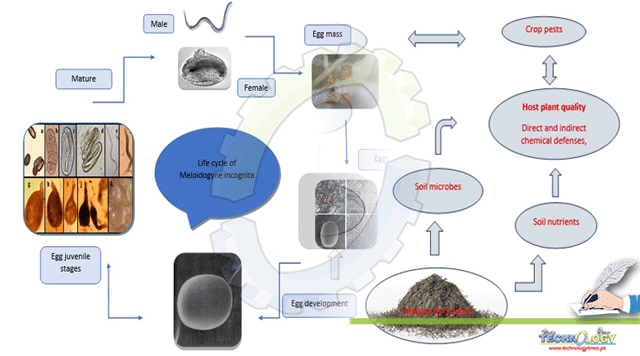Solanum melongena is an economically pivotal and prevalent vegetable crop in all over the world and Its fruit has different diversity in shape, color and size. The colour of the brinjal fruitsare black, purple white, yellow and purple.

By Muhammad Yasir, Fouzia Perveen, Areej Fatima
BRINJAL (Solanum melongena)
The flower of brinjal plants are hermaphrodite as well as self-pollination also occur in them and its fruit used for the treatment and prevention of many diseases such as help in the digestion process, get rid of waste generating urine and split headache. Brinjal plants are summer cultivating vegetable and its season begins in June and finishes in mid-November.
The brinjal plant is high in nutritional content and contains a variety of minerals like vitamin K, C, iron, calcium, potassium, calories, protein, manganese, folate, and fiber.
Meloidogyne incognita
- Incognita is a plant parasitic nematode that lives in soil and attacks plant roots, causing the most harm in light sandy soil with minimal clay content and it moves quickly and causes damage to the host plant.
Life cycle of Meloidogyne incognita
It is free-living soil nematode specie and they feed on the crop root. The male and female root knot M. incognita nematode morphologically distinguish like that male are wormlike and it is 1:2 to 1.5 millimeters long by 30 to 36 micrometers in diameter and female are pear shape about 0.40 to 1.30-millimeter-long by 0.27 to 0.75 millimeters wide.
The female lays 500 eggs, and the first and second stage juveniles are wormlike and develop in the egg, whereas the second stage juveniles emerge from an egg in the soil and are the M. incognita nematode’s infected stage. At this stage, the nematode has reached the host and the juvenile has entered the root and the nematode feeds on the cell by inserting its stylet and secreting saliva into the cell.
The nematode has completed its second molt and has developed into a third-stage juvenile and it has now progressed to the third molt and has developed into a fourth-stage juvenile. At the fourth stage the nematode can be distinguish at either male or female and now the male emerges from the root which become free living in the soil and female continue to grow in thickness and appear in pear shape.
Life cycle of M-incognita is completed in 25 days at 27degree due to temperature differences it may be lower or higher. When the egg hatches after the migration of infected second stage juveniles to the neighboring area of the root, it generates a new infection in the same root or infects other roots or roots of other plants. The majority of root knot M-incognita nematodes are found in the root zone, 5 to 25 cm below the surface, and root knot nematodes segregate by sticking to farm equipment in water and soil.
Control of nematode disease in brinjal plant by using poultry and livestock manure
The nitrogen content of poultry dung is high, and nitrogen compound ammonification was found to be nematicidal.
Among the nematode parasites targeting a brinjal crop, the root knot nematode M-incognita stands out as one of the most devastating in vegetable fields. Because they feed on the roots of brinjal plants, they increase the creation of galls and root system malfunction, affecting plant growth and productivity.
The production of root gall index and malfunctioning is reduced by using a highest rate poultry manure and cow dung as a result nematode population density in the soil increase the brinjal yield. Amalgamation of poultry manure and cow dung in nematode-overspread field has the potentials to suppress nematode population and reduce its damaging effects. Poultry manure composed a large number of natural nutrients. It contains a 0.5% to 0.9% nitrogen, 0.4% to 0.5% phosphorus and 1.2% to 1.7% potassium, cow dung is also containing a large number of organic materials and natural nutrients which is formed from grass and grain digestion. It contains a 3% nitrogen, 2% phosphorus and 1% potassium. Poultry manure and cow dung contains a high level of ammonia which is highly toxic for root knot M-incognita nematode in brinjal crop.